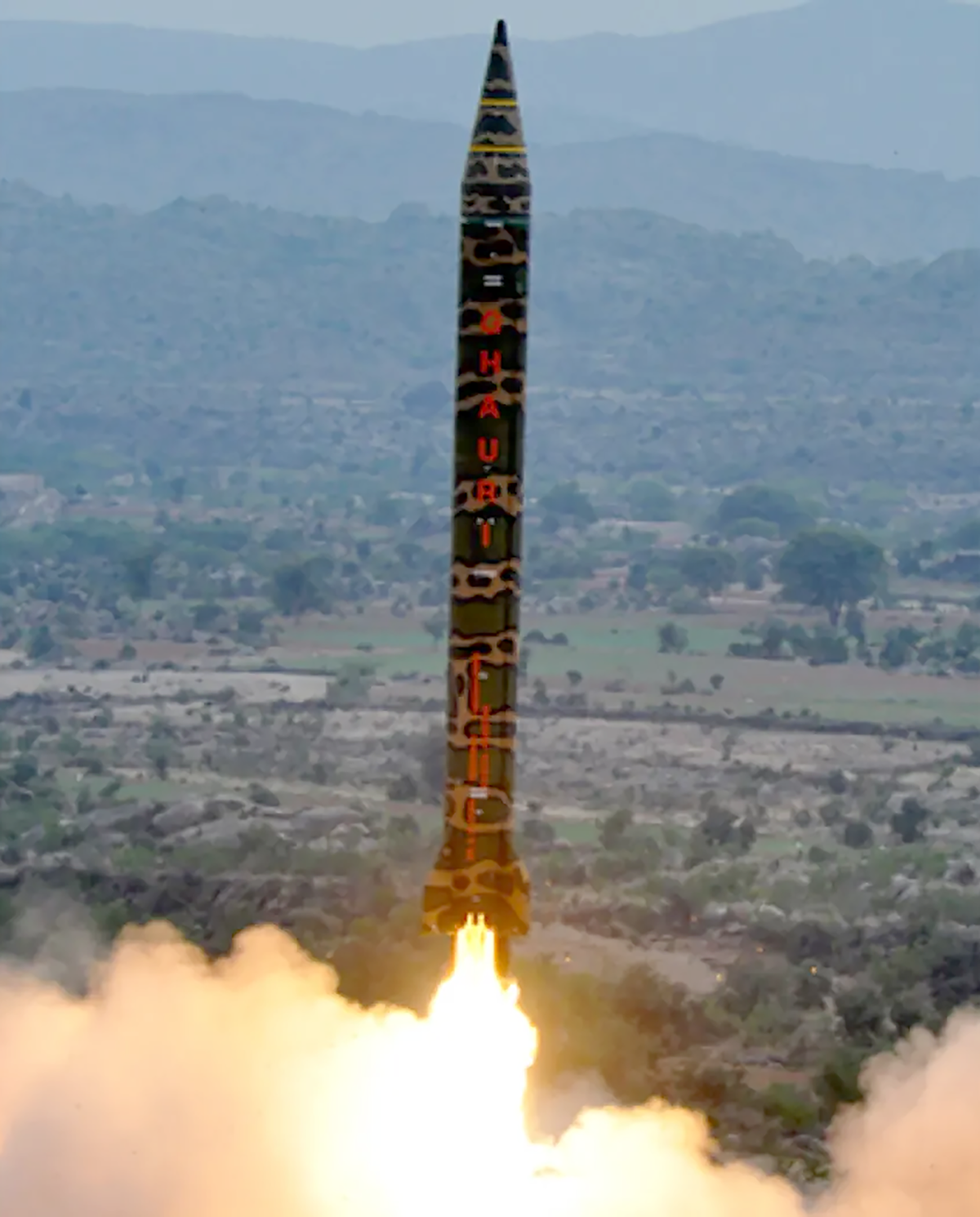By Interaction Team
The Ghauri (Hatf 5) constitutes a significant aspect of Pakistan’s ballistic missile capabilities, functioning as a road-mobile system thrust by liquid propellants. Within Pakistan’s arsenal, it holds the distinction of being the most extensively tested missile system, highlighting its reliability and operational preparedness. The missile is deployed and launched using a dedicated transporter erector launcher, accentuating its mobility and versatility in diverse strategic scenarios.
Name/Codename of the missile
The missile was named after the 12th-century Sultan Shahabuddin Ghauri by a senior scientist involved in the program upon its development. Sultan Muhammad Ghauri, renowned for his successful campaigns in the northwestern region of India, defeated Prithviraj in 1192 and formally established his kingdom in 1206.
Despite this historical association, the missile has been officially codenamed “Hatf5” by the Joint Staff Headquarters (JS HQ). The Hatf codename is derived from the name of the sword of the holy Prophet Muhammad (PBUH).
Versatility and distinctiveness
The versatility of the Ghauri weapon system, in alignment with other Pakistani ballistic missiles, is of notable consideration. It can be deployed with both conventional and nuclear capabilities. The missile’s guidance system is a pivotal feature, utilizing a combination of inertial guidance and terminal guidance systems throughout its trajectory. This dual-system approach significantly enhances precision and control over its flight path.
The comprehensive development and design of the missile have been conducted at the Khan Research Laboratories (KRL), emphasizing the indigenous expertise and technological prowess integral to its creation. While bearing a noticeable visual resemblance to North Korea’s Nodong-1 MRBM, the Ghauri distinguishes itself through its advanced capabilities.
Genesis of the Ghauri-I
The foundational phase of the Ghauri weapon system, designated as Ghauri-I, took shape during the late 1980s and early 1990s. Boasting a range of 1250-1500 km, a length of 15.9 m, a body diameter of 1.35 m, and a launch weight of 15,850 kg, this iteration showcased remarkable versatility by accommodating various payloads, including nuclear weapons, chemical agents, high explosives, or sub-munitions.
Inaugural test and deployment
The Ghauri-I underwent its inaugural test launch on April 6, 1998, at the Tilla Test Firing Range near Malute, Jhelum Cantt. Deployed from a transporter erector launcher, the missile successfully struck its designated target in the Baluchistan desert, marking a significant milestone. Though reports indicate its entry into service in 2003, but some other sources claim that its full feasibility was established after a successful flight test in 2004. Acknowledged by the Pakistani military as a nuclear weapon-delivery capable missile, Ghauri-I demonstrated versatility by accommodating various warhead types.
In contrast to the collaborative Shaheen program involving Pakistan’s Air Force and Army, the Ghauri program is exclusively focused on the defined objectives of the Pakistan Army. Particularly, its primary goal was to achieve high accuracy in targeting the enemy’s valuable assets.
Ghauri’s variants
The subsequent evolution in the Ghauri missile series, Ghauri-2, commenced two years after the introduction of its predecessor, Ghauri-1, under the guidance of the Khan Research Laboratories (KRL). Serving as a more extended-range adaptation of the Hatf 5, Ghauri-2 underwent significant modifications, including the substitution of the previously employed heavy steel construction with a more lightweight aluminum alloy. Additionally, the propulsion system was upgraded with enhanced propellants, contributing to an overall improvement in performance.
This second iteration of the Ghauri missile boasted an elongated motor assembly, coupled with the incorporation of superior propellants, resulting in a notable increase in its operational range to 2,300 km.
On the other hand, Ghauri-III, presumed to be an intermediate-range ballistic missile capable of covering distances ranging from 3,000 to 3,500 km, lacks detailed information, and reports suggest that its development came to a halt during the developmental process.
Recent test flight, liquid-fuel technology, and potential applications
Pakistan has effectively conducted numerous training launches of the Ghauri medium-range ballistic missile since its inception. The most recent launch, as reported by the military’s media branch, ISPR, took place on 24/10/2023. The purpose of this launch was to assess the “operational and technical readiness of Army Strategic Forces Command.”
Mansoor Ahmed, an authority on Pakistan’s nuclear program, commented on the test, stating, “While this specific test serves as a training exercise, it not only validates enhanced technical and performance parameters but also presents an economical avenue for testing new reentry vehicle technologies.” He further emphasized that the Ghauri, being the sole liquid-fueled ballistic missile in Pakistan’s strategic forces, provides valuable experience in liquid-fueled technology, potentially paving the way for the development of a satellite launch vehicle if Pakistan opts for that path.
Ahmed clarified that the Ghauri is powered by TM-185, a mixture of gasoline and primarily kerosene, along with fuming nitric acid. He highlighted that although kerosene has historically been used for space rocket applications, but fuming nitric acid is not commonly employed.
A more conventional combination, he noted, would involve kerosene and high-test peroxide, potentially offering a higher specific impulse translating to greater efficiency in delivering cargo to orbit.
In conclusion, the Ghauri missile system stands as one of the fundamental pillars of Pakistan’s ballistic prowess. Its recent test features its operational readiness and hints at its potential applications in reentry vehicle technologies. With a dual-guidance system, capable of handling conventional and nuclear payloads, the Ghauri missile weapon system enhances Pakistan’s arsenal, contributing to the bolstering of Pakistan’s national security.


